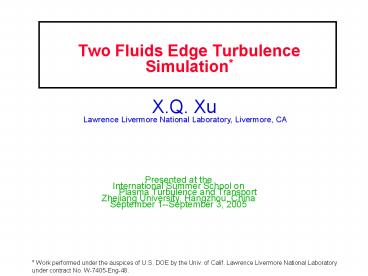Two Fluids Edge Turbulence Simulation - PowerPoint PPT Presentation
1 / 28
Title:
Two Fluids Edge Turbulence Simulation
Description:
Zhejiang University, Hangzhou, China. September 1--September 3, 2005 ... Hangzhou. 09/02/2005 5. Spectrum of the GPI data is ... Hangzhou. 09/02/2005 14 ... – PowerPoint PPT presentation
Number of Views:55
Avg rating:3.0/5.0
Title: Two Fluids Edge Turbulence Simulation
1
Two Fluids Edge Turbulence Simulation
X.Q. Xu Lawrence Livermore National Laboratory,
Livermore, CA
Presented at the International Summer School on
Plasma Turbulence and Transport Zhejiang
University, Hangzhou, China September
1--September 3, 2005
Work performed under the auspices of U.S. DOE
by the Univ. of Calif. Lawrence Livermore
National Laboratory under contract No.
W-7405-Eng-48.
2
Diverted tokamak magnetic fusion device and its
poloidal Cross Section
3
Time Trace of Line-averaged Density in a typical
Density Limit Experiment
0
1
2
Time (s)
M. Greenwald, Plasma Phys. Control. Fusion 44
(2002) R27-R80
4
Quasi-coherent mode concurs with EDA H-mode
5
Spectrum of the GPI data is compared with that of
the BOUT simulation
6
BOUT is 3D EM Boundary Plasma Turbulence Code
- Braginskii --- collisional, two-fluids
electromagnetic equations - Realistic X-point geometry
- openclosed flux surfaces
- BOUT is being applied to DIII-D, C-mod, NSTX,
MAST, ITER (for Snowmass), ... - LOTS of edge fluctuation data!
- BES, GPI, PCI, Probe, and Reflectometer
- Provide excellent opportunity for validating BOUT
against experiments. - BOUT code has been benchmarked with a 2D
transport code UEDGE for 2D transport problems.
7
BOUTs Dynamic Equations
8
BOUTs Dynamic Equations---Cont.
9
BOUTs Subsidiary Equations and Definitions
10
BOUT uses SOL Sheath Boundary Conditions
11
Extension to BOUTs equations
12
BOUT Uses Quasi-Ballooning Coordinate
13
BOUT is a parallelized 3D nonlocal
electromagnetic turbulence code using MPI
- The BOUT code solves for the plasma fluid
equations in a 3D toroidal segment - BOUT uses a fully implicit Newton-Krylov solver
PVODE - BOUT is a parallelized code based on domain
decomposition that uses the MPI system
14
Local Saftey Factor, has strong
variations near X-point that affects mode
15
Density fluctuation is ballooning for X-point
gemo.vs.flute for shifted-circle
16
Density Limit Studies
- Achieving high energy confinement at high density
is important - fusion power Pfus ? n2 lt?vgt
- Density limits have been observed on Tokamaks,
and other toroidal devices - In tokamaks, the limit ultimately leads to
disruptions - Greenwald empirical scaling law works well
- nG Ip/?a2
- Tokamak scenario
- current profile shrinkage-?MHD
instability?disruption - what leads to the collapse of current
profile? - Over 40 years, many theoretical models have been
developed, nothing is conclusive yet. - Most work, to date, has concentrated on impurity
radiation as the principal drive. - PradnenzR(Te)
17
Discharges with good confinement are achieved at
densities above the empirical limit by pellet
fueling in DIII-D
- Because the density limit is due to edge physics,
plasmas with peaked density profiles can reach
higher densities than those with flat profiles. - The concomitant accumulation of impurities leads
to a strong increase in radiation and discharge
termination.
18
Density Limit High collisionality drives
fluctuationlevel/transport up parallel
correlation length down
19
At high density, perpendicular turbulence
transport gtgt parallel transport, destroying the
edge shear layer
- D ? as n ? , but D exhibits a discontinuous
behavior? catastrophic boundary crossed - Destruction edge shear layer ? the region of
large transport extends inward - The same mechanism may operate in other
configurations
20
BOUT shows Paradigm Er Generation and Turb.
Suppression by the Shear.
21
BOUT simulations show a favorable Transport
Scaling with Current(Fixed q, q955 at high
density)
22
Large transport boundary vs. current and
densityis consistent with expt. operational
limits
- P is held fix while n changes
- No change w/ Bt while Ip is fixed
- Greenwald Limit NGIp/?a2
- (with n 1020 /m3, Ip MA, am)
- q is held fix while Ip changes
- Transport coefficient at LCFS
- Large transport leads to a collapse of edge plasma
23
Large perpendicular transport leads to an X-point
MARFE
- Use convective velocity Vr increasing from 0 to
300 m/s between sep. and wall - Vr peaked around outer midplane of SOL
- Large perpendicular transport yields peaked
density and radiation near the X-point due to
neutral penetration
24
A simple analytical neutral mode added
25
Blob Vorticity at Maximum Density (0) and
Vorticity Dipole Extrema()
Poloidal y
Time (ms)
Blobs are born near the separatrix with net
vorticity or rotation (0). The dipole ()
blossoms with detachment and persists after the
overall rotation has subsided. For
sheath-connected blobs, the rotation subsides on
the timescale of the electron temperature
relaxation since it is caused by the radial
gradient in the Bohm sheath potential Te(r).
26
2D simulations reveal the blob propagation and
its evolution of mushroom shape due to K-H
instability
Blobs are unstable due to Kelvin-Holmhotz
instability
Bain, et al., Physics of Plasma, Vol.10,
671(2003)
27
Analysis indicates a decorrelation of turbulence
between the midplane and divertor leg
Cross-correlation analysis of BOUT simulation by
GKV shows effect to strong X-point magnetic shear
28
SUMMARY































